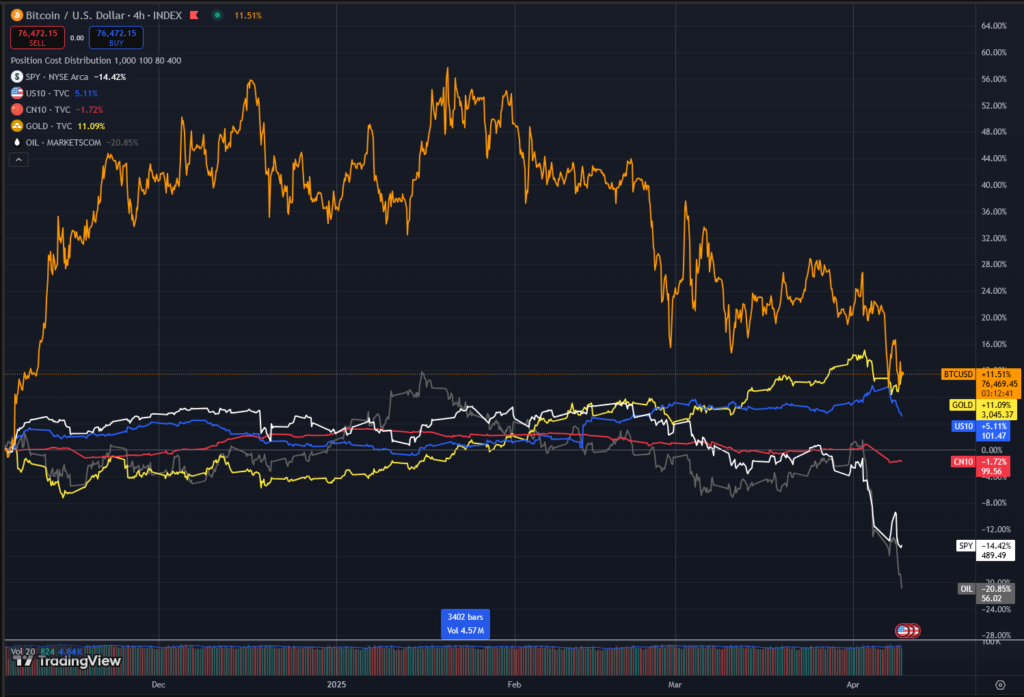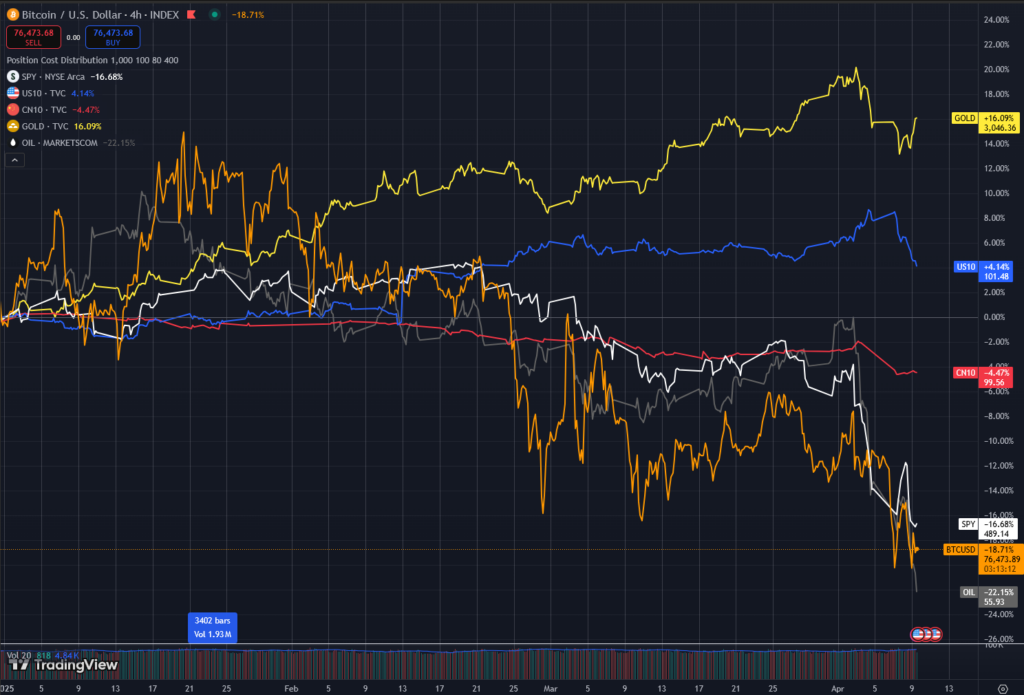Bitcoin is experiencing a downturn in April, relinquishing most of its Q1 gains as global markets respond to mounting trade tensions between the US and China.
This shift, connected to the ongoing US trade conflict, unfolds alongside a broader reevaluation of assets, with Treasury yields decreasing, oil prices plummeting, and stock markets nearing correction levels.
The chart above illustrates the immediate market response following the announcement of extensive trade penalties by President Trump on April 2.
In just a few days, oil prices dropped by 20.92%, SPY declined by 10.23%, and Bitcoin fell by 7.34%. Bond prices also saw a dip, with US10 and CN10 down 2.42% and 2.58%, respectively, which indicates rising yields.
Traditionally considered a safe haven, gold decreased by 2.83%, suggesting liquidity stress and a risk-averse sentiment affecting various asset classes.
Bitcoin’s relative performance, which declined less than SPY and oil but more than bonds and gold, suggests that despite narratives around strategic reserves, it remains somewhat connected to broader market volatility during heightened economic strain.


The overall performance since the election of Donald Trump emphasizes Bitcoin’s relative resilience.
Since the November 2024 US election, Bitcoin has increased by 11.51%, with gold closely following at 11.09%. Both assets have managed to maintain their value while traditional markets faced significant re-evaluations. In contrast, SPY has fallen by 14.42%, and oil prices have plummeted over 20%, reflecting a broad stress in the market.
Meanwhile, the prices of US and Chinese 10-year bonds (US10 and CN10) have decreased by 5.11% and 1.72%, respectively, indicating expectations of sustained inflation or increased issuance.
The majority of this decline was triggered by President Trump’s April 2 declaration of a national emergency regarding trade deficits and the enforcement of a 104% tariff on Chinese imports.
In retaliation, China imposed an 84% tariff on US goods, which Beijing labeled as non-negotiable.
Bitcoin’s Correlation with Macro Developments Intensifies
Initially, Bitcoin’s performance following Trump’s inauguration was aligned with a favorable policy climate, supported by public endorsement of cryptocurrency adoption and efforts to bring production back home, creating a bullish sentiment around digital assets. However, recent data indicates that Bitcoin is mostly moving in tandem with risk assets rather than decoupling from them.
The recent declines in SPY and the reversal in Treasury yields reflect changing expectations. Markets are starting to anticipate slower growth, reduced consumer spending, and more cautious investment strategies. Projections suggest a 0.9 percentage point decrease in real GDP for 2025, with the average household expected to face an additional $3,800 in costs stemming from the tariff policy.
Despite a generally favorable long-term policy environment, Bitcoin has not been able to escape the volatility associated with global liquidity and demand issues. Institutional investors seem to be pulling back from exposure to risk-sensitive assets, including cryptocurrencies, as the probability of recession increases.
Currently, the likelihood of a global recession is estimated at 60%, up from a prior forecast of 40%. Similarly, projections for a recession within the US have been raised to 45%. Concerns are growing that prolonged tariffs could lead to ongoing inflation, increased asset volatility, and diminished investment confidence.
Global Bond Divergence Constricts Bitcoin’s Safe-Haven Appeal
While US Treasury yields have sharply declined, the dynamics in China’s sovereign bond market reflect a different set of stress indicators. The yield on China’s 10-year bonds has fallen to 1.65%, decreasing 65 basis points from the previous year.
Data reveals ongoing yield drops across the 2Y, 5Y, and 30Y curves, suggesting deflationary pressures and limited potential for growth recovery amid weak external demand.
Recent adjustments in GDP forecasts for China highlight expectations that US tariffs could slash Chinese exports significantly, potentially dragging growth down by more than a percentage point.
With both US and Chinese government bonds factoring in downside growth risks, Bitcoin’s function as a global reserve hedge grows more complex.
Institutional investors might hold off on additional allocations until market liquidity stabilizes or there is more clarity in policy direction.
Trump’s characterization of Bitcoin as a digital commodity suitable for reserve use resonates within segments of the crypto community, but practical implementation remains uncertain. Presently, many investors seem more focused on macroeconomic trends than political cues.
Bitcoin’s Prospects Amidst Recession Concerns
The overarching narrative positioning Bitcoin as a hedge against geopolitical risks, an inflation safeguard, or a programmable reserve asset remains in place.
However, during periods of macroeconomic stress, correlations among risk assets generally rise. The recent price behavior suggests that Bitcoin is not yet perceived as a risk-off asset when liquidity is constrained.
Bitcoin might find advantageous policy support if the government escalates initiatives specific to Bitcoin, rolls out digital treasury options, or formalizes state-held Bitcoin reserves. Until then, market participants are viewing the asset through a macroeconomic lens. Price movements remain closely linked with risk assessment, recession forecasts, and overall liquidity across assets.
Since late March, Brent crude oil has seen a decline of over 20%, accompanied by decreasing forward spreads and rising surplus pricing. Decreased consumer demand, diminished export orders, and pressured manufacturing profits all contribute to broader market adjustments.
As part of the overall allocation framework, Bitcoin remains responsive to these broader market dynamics.
Year-to-date, Bitcoin ranks as one of the poorest performing assets, second only to oil.


This divergence highlights how Bitcoin and gold are managing trade war-induced volatility better than oil, stocks, or the sovereign debt markets, suggesting that Bitcoin has demonstrated relative strength even as global liquidity tightens.
Nonetheless, no other asset can rival gold’s performance, which is up 16% in 2025.
